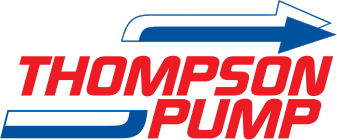Construction Commences at the Warwick WWTP, Warwick, RI
Thompson Pump’s Northeast Branch, along with its distributor, J. J. Gregory of Providence, RI, were instrumental in assisting a local construction company with the construction of three major facilities located within the Warwick Waste Water Treatment Plant, in Warwick, RI. Constituting one of the largest dewatering projects ever undertaken in Rhode Island, the construction of the plant’s North Bio-Treatment Tank, South Bio-Treatment Tank and the Gravity Thickener/Bio-Lifter facility would prove no easy task.
One obstacle was found in the soil conditions. The characteristics of the soil on the project site showed that the ground was hard and wellpoints would have to be installed by jetting them into the ground.
This method of installing wellpoints requires the aid of a high-pressure jet pump. The high-pressure jet pump is connected to the top of the riser pipe by a small diameter jet hose. The pump sucks water from the source and discharges through a small diameter port to a small diameter hose. The hose, through the connection, is directed into the top of the riser pipe, and eventually makes its way through to the wellpoint itself. The high-pressure water helps “dig” the wellpoint and riser pipe into the ground, thereby installing the wellpoint to the desired length. Because of the tough soil conditions, this process had to be used for each system until all of the required wellpoints were installed.
Another obstacle was the sites for these structures were in close proximity to existing buildings. The structural integrity of the existing buildings needed to be protected from the excavation and other construction. Because of this, steel sheeting was installed prior to dewatering while construction proceeded.
Thompson Pump supplied two 12-inch Rotary Wellpoint Pumps, which were used as the primary units, and would handle the wellpoint systems inside and outside the sheeting. Thompson Pump also supplied an 8-inch Compressor-Assisted High Pressure Solids Handling Pump with the Enviroprime® Priming System to be used as 100% standby. Approximately 940-feet of header pipe, 280 wellpoints and various riser pipes, elbows, tees, caps and other accessories were also supplied in order to complete the wellpoint systems and cover the area of each of the three different construction sites – the largest being 205’ x 110’.
Once the sheeting was in place, the two wellpoint systems were installed: one installed inside the sheeting, and one outside the sheeting. This ensured that the groundwater was effectively removed. Each wellpoint system was installed and was operating continuously so excavation could begin. The wellpoint systems were capable of removing the groundwater 25-feet below the surface, which was well over the excavation depth requirement of 16-feet below the surface. As the wellpoint systems lowered the water table, excavation was able to begin.
Thompson’s Rotary Wellpoint Pumps were able to lower the water table quickly to allow excavation to begin before schedule. While excavation took place, the pumps were still in operation allowing the excavation to operate successfully.
